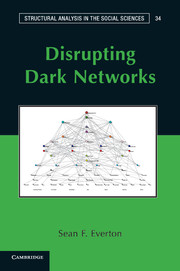Book contents
- Frontmatter
- Contents
- Figures
- Tables
- Preface
- Acknowledgments
- Part I Introduction
- Part II Social Network Analysis: Techniques
- Part III Social Network Analysis: Metrics
- Part IV Social Network Analysis: Advances
- 10 Dynamic Analyses of Dark Networks
- 11 Statistical Models for Dark Networks
- Part V Conclusion
- Appendix 1 The Noordin Top Terrorist Network
- Appendix 2 Glossary of Terms
- Appendix 3 Multidimensional Scaling with UCINET
- Appendix 4 The Just War Tradition
- References
- Index
11 - Statistical Models for Dark Networks
Published online by Cambridge University Press: 05 April 2013
- Frontmatter
- Contents
- Figures
- Tables
- Preface
- Acknowledgments
- Part I Introduction
- Part II Social Network Analysis: Techniques
- Part III Social Network Analysis: Metrics
- Part IV Social Network Analysis: Advances
- 10 Dynamic Analyses of Dark Networks
- 11 Statistical Models for Dark Networks
- Part V Conclusion
- Appendix 1 The Noordin Top Terrorist Network
- Appendix 2 Glossary of Terms
- Appendix 3 Multidimensional Scaling with UCINET
- Appendix 4 The Just War Tradition
- References
- Index
Summary
Introduction
It is not uncommon when attempting to tease out the causes of a particular outcome that several potential factors are identified, all of which are correlated with the outcome of interest but may not be actual causes. For example, a strong correlation exists between checking into a hospital and subsequently dying. However, few would argue that checking into a hospital typically increases the chance that someone will die. Instead, the correlation between the two events exists because people who are extremely ill and thus have a higher probability of dying are more likely to check into a hospital than are those who are in good health. This correlation is referred to as spurious because it is due to the presence of a third factor, which, in this example, is the state of one's health.
It is also possible for a variable to appear to have either no effect or a negative effect on a particular outcome, when in fact it has a positive one. To illustrate this, consider the following (purely hypothetical) example (adapted from an example presented in Starbird 2006), which cross tabulates whether members of a particular dark network attended college with whether they are a key player (see Chapter 8). If we relied solely on the data presented in Table 11.1, we would probably conclude that attending college reduces the likelihood that a network member will be a key player: 70 percent of members who have not attended college are key players, whereas only 60 percent of those who have attended college are.
- Type
- Chapter
- Information
- Disrupting Dark Networks , pp. 343 - 362Publisher: Cambridge University PressPrint publication year: 2012



